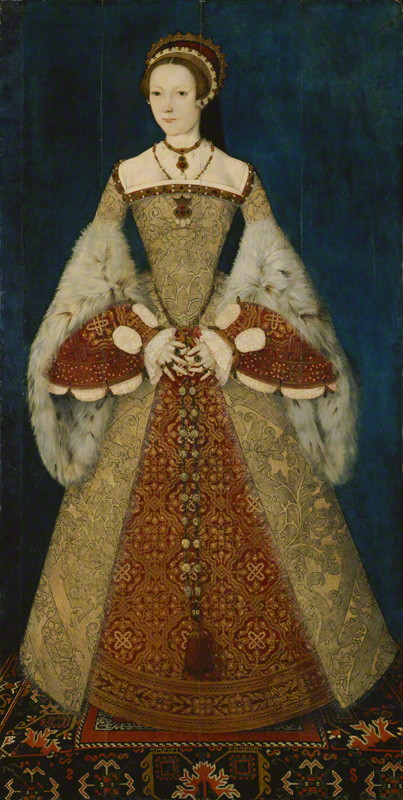Case Study 6: Catherine Parr attributed to Master John c.1545
This example illustrates some of the problems surrounding identification of portraits. The author draws attention to the need to evaluate the reliability of supporting evidence: how far can Holland’s statement of accuracy be accepted? Is the traditional identification of the late copy reliable? He also highlights the difficulties that arise when portraits of individuals connected by family ties have very similar provenances.
The portrait was re-identified as of Catherine Parr by Susan E. James in ‘Lady Jane Grey or Queen Kateryn Parr?’ Burlington Magazine, cxxxviii, January 1996, pp.20-24), and can be found on the National Portrait Gallery’s website under the name Catherine Parr.
“The grand, full-length state portrait of Lady Jane Grey (NPG, 4451) presents a fairly difficult case of identity. The picture first turned up at Glendon Hall, the home of the Lane family, in the early 18th century, where it was identified as Catherine Parr, Henry VIII’s last wife; Ralph Lane had married the heiress of William, Lord Parr, the uncle of the Queen.
The NPG portrait, which dates on style and costume from about 1545, clearly represents a young girl, and cannot, therefore, be Catherine Parr, who was then middle-aged. The coroneted pendent jewel which the sitter wears at her breast appears to be the same as that shown in an engraving of Lady Jane Grey published in Henry Holland’s Herwologia (1620).
Holland is categorical in his statement that if he failed to obtain a true likeness he excluded the sitter from the volume. In an annotated copy of the Herwologia, the engraving is said to come from ‘Mr Jo: Harisons, Halbens’. The face in the NPG portrait, which has been overpainted, also tallies in x-ray with the features of the sitter represented in the engraving. Further evidence is supplied by a late copy of the NPG type (collection of Lord Hastings), probably after another lost Tudor portrait, which has always been known as Lady Jane Grey.
The confusion with Catherine Parr is understandable, since Lady Jane Grey was brought up in her household; a portrait of either lady could be expected to have the same provenance. The NPG picture has been tentatively attributed to Master John, on comparison with the documented portrait of Mary I by him, also in the collection. It derives in format from Holbein’s portrait of the Duchess of Milan (National Gallery), though it is much more abstract and formalized. It represents Lady Jane Grey as a great court lady, rather than as the tragic victim of historical romance.”
RL Ormond, ‘The National Portrait Gallery archive’, Journal of the Society of Archivists, 4 (1970), 130-136)

